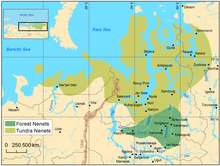Nenets languages
Topic: Social
 From HandWiki - Reading time: 4 min
From HandWiki - Reading time: 4 min
| Nenets | |
|---|---|
| ненэцяʼ вада nenécja' vada | |
| Native to | Russia |
| Region | Nenets Autonomous Okrug, Yamalo-Nenets Autonomous Okrug, Krasnoyarsk Krai, Komi Republic, Murmansk Oblast[citation needed] |
| Ethnicity | 49,787 (2020 census)[1] |
Native speakers | 38,405 (2020 census)[2] |
| Dialects |
|
| Language codes | |
| ISO 639-3 | yrk |
| Glottolog | nene1251[3] |
 | |
Nenets (in former work also Yurak) is a pair of closely related languages spoken in northern Russia by the Nenets people. They are often treated as being two dialects of the same language, but they are very different and mutual intelligibility is low. The languages are Tundra Nenets, which has a higher number of speakers, spoken by some 30,000 to 40,000 people[6][7] in an area stretching from the Kanin Peninsula to the Yenisei River,[8] and Forest Nenets, spoken by 1,000 to 1,500 people in the area around the Agan, Pur, Lyamin and Nadym rivers.[6][7]
The Nenets languages are classified in the Uralic language family, making them distantly related to some national languages spoken in Europe – namely Finnish, Estonian, and Hungarian – in addition to other minority languages spoken in Russia. Both of the Nenets languages have been greatly influenced by Russian. Tundra Nenets has, to a lesser degree, been influenced by Komi and Northern Khanty. Forest Nenets has also been influenced by Eastern Khanty. Tundra Nenets is well documented, considering its status as an indigenous and minority language. It has a literary tradition going back to the 1930s, while Forest Nenets was first written during the 1990s and has been little documented.[7]
Apart from the word 'Nenets', only one other Nenets word has entered the English language: 'parka', their traditional long, hooded jacket, made from skins and sometimes fur.[9][10][unreliable source?]
Common features of Nenets languages
Tundra Nenets has 16 moods, most of which reflect different degrees of certainty in what in English might be called indicative statements or different degrees of force in what in English might be called imperative commands.[11] An overarching feature of the Nenets languages is the introduction of systematic palatalization of almost all consonants. This originates from contrasts between different vowel qualities in the Proto-Samoyedic language.[12]
- *Cä, *Ca → *Cʲa, *Ca
- *Ce, *Cë → *Cʲe, *Ce
- *Ci, *Cï → *Cʲi, *Ci
- *Cö, *Co → *Cʲo, *Co
- *Cü, *Cu → *Cʲu, *Cu
The velar consonants *k and *ŋ were additionally shifted to *sʲ and *nʲ when palatalized.
Similar changes have also occurred in the other Samoyedic languages spoken in the tundra zone: Enets, Nganasan and the extinct Yurats.
Differences between Tundra and Forest Nenets
Tundra Nenets generally has remained closer to Proto-Nenets than Forest Nenets, whose phonology has been influenced by eastern Khanty dialects. Changes towards the modern languages include:[13][12]
- Tundra Nenets:
- Delabialization of /wʲ/ → /j/
- Lenition of initial /k/ → /x/
- Simplification of /ʔk/ → /k/
- Forest Nenets:
- Initial /s/ → /x/
- Medial denasalization of /nʲ/ → /j/
- The change of rhotics to lateral fricatives: /r/, /rʲ/ → /ɬ/, /ɬʲ/
- Shortening of geminate nasals
- Breaking of geminate /lː/ → /nɬ/
- Phonemicization of palatalized velars /kʲ/, /xʲ/, /ŋʲ/ due to vowel changes
- Raising of non-close vowels preceding a syllable with an original close vowel
- Loss of vowel distinctions in unstressed syllables
- Introduction of short/long contrasts for /a/ and /æ/
See also
- Maria Barmich
References
Note
- ↑ "Росстат — Всероссийская перепись населения 2020". https://rosstat.gov.ru/vpn_popul.
- ↑ "Итоги Всероссийской переписи населения 2020 года. Таблица 6. Население по родному языку.". https://rosstat.gov.ru/vpn_popul.
- ↑ Hammarström, Harald; Forkel, Robert; Haspelmath, Martin, eds (2017). "Nenets". Glottolog 3.0. Jena, Germany: Max Planck Institute for the Science of Human History. http://glottolog.org/resource/languoid/id/nene1251.
- ↑ Rantanen, Timo; Tolvanen, Harri; Roose, Meeli; Ylikoski, Jussi; Vesakoski, Outi (2022-06-08). "Best practices for spatial language data harmonization, sharing and map creation—A case study of Uralic" (in en). PLOS ONE 17 (6): e0269648. doi:10.1371/journal.pone.0269648. PMID 35675367. Bibcode: 2022PLoSO..1769648R.
- ↑ Rantanen, Timo, Vesakoski, Outi, Ylikoski, Jussi, & Tolvanen, Harri. (2021). Geographical database of the Uralic languages (v1.0) [Data set]. Zenodo. https://doi.org/10.5281/zenodo.4784188
- ↑ 6.0 6.1 "Nenets". http://www.ethnologue.com/show_language.asp?code=yrk.
- ↑ 7.0 7.1 7.2 Salminen, Tapani, Ackerman, Farrell (2006). "Nenets". in Brown, Keith. Encyclopedia of Languages & Linguistics. 8 (2 ed.). Oxford, England: Elsevier. pp. 577–579.
- ↑ Staroverov, Peter (2006). Vowel deletion and stress in Tundra Nenets. Moscow, Russia. p. 1.
- ↑ "parka", Merriam-Webster Online Dictionary
- ↑ Games, Alex (2007). Balderdash & Piffle: One Sandwich Short of a Dog's Dinner. London: BBC. ISBN 978-1-84607-235-2. https://archive.org/details/balderdashpiffle0000game.
- ↑ "Tundra Nenets grammatical sketch". http://www.helsinki.fi/~tasalmin/sketch.html.
- ↑ 12.0 12.1 Sammallahti, Pekka (1988), "Historical phonology of the Uralic languages, with special reference to Samoyed, Ugric, and Permic", The Uralic Languages: Description, History and Foreign Influences, Leiden: Brill, pp. 478–554
- ↑ Salminen, Tapani (2007), "Notes on Forest Nenets phonology", Mémoires de la Société Finno-Ougrienne (Helsinki, Finland: Suomalais-Ugrilainen Seura) (253), http://www.sgr.fi/sust/sust253/sust253_salminen.pdf
External links
| Nenets languages test of Wikipedia at Wikimedia Incubator |
- Tundra Nenets website
- Forest Nenets – English glossary
- The Russian–Nenets Audio Phrasebook
- Comparative Nenets–Nganasan dictionary (with Russian and English equivalents)
 |
 KSF
KSF